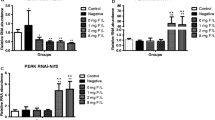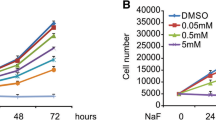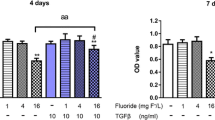Abstract
The objective of this study was to determine the expression of classic bone markers and unfolded protein response (UPR) signaling factors through MC3T3-E1 cells exposed to varying concentrations of fluoride. Excessive fluoride exposure caused the skeletal disease. During this process, osteoblasts played a critical role in the advanced skeletal fluorosis. Recent literature showed that endoplasmic reticulum (ER) stress and UPR were involved in numerous aspects of bone biology. Our results indicated that co-exposure of low-dose fluoride and mineral induction medium stimulated the expression of alkaline phosphatase, runt-related transcription factor 2 (Runx2), and osterix in MC3T3-E1 cells. Accordingly, the expression of double-stranded RNA-activated protein kinase (PKR)-like ER kinase, activating transcription factor 6, and X-box binding protein 1 also increased under the same fluoride exposure condition. The upregulation of three UPR factors was similar with osteogenic differentiation markers and transcription factors, which implied the relation between osteoblast differentiation and UPR pathways. Moreover, the role of UPR affecting osteoblast differentiation was investigated by decreasing the expression of binding immunoglobulin protein (BiP) mRNA through small interfering RNA (siRNA) technique. BiP knockdown led to suppress activation of UPR pathways. The deletion of BiP expression hardly stimulated the osteogenic cells differentiation but inhibited cell function under fluoride and mineralization induction exposure. In conclusion, fluoride had dual effect on osteogenic action. The UPR possibly involved in the mechanism of osteoblasts differentiation induced by fluoride.








Similar content being viewed by others
References
Lundy MW, Wergedal JE, Teubner E et al (1989) The effect of prolonged fluoride therapy for osteoporosis: bone composition and histology. Bone 10:321–327
Bellows CG, Heersche JN, Aubin JE (1990) The effects of fluoride on osteoblast progenitors in vitro. J Bone Miner Res 5:S101–S105
Wergedal JE, Lau KH, Baylink DJ (1988) Fluoride and bovine bone extract influence cell proliferation and phosphatase activities in human bone cell cultures. Clin Orthop Relat Res 233:274–282
Farley JR, Wergedal JE, Baylink DJ (1983) Fluoride directly stimulates proliferation and alkaline phosphatase activity of bone-forming cells. Science 222:330–332
Khokher MA, Dandona P (1990) Fluoride stimulates [3H]thymidine incorporation and alkaline phosphatase production by human osteoblasts. Metabolism 39:1118–1121
Rodriguez JP, Rosselot G (2001) Sodium fluoride induces changes on proteoglycans synthesized by avian osteoblasts in culture. J Cell Biochem 83:607–616
Kassem M, Mosekilde L, Eriksen EF (1994) Effects of fluoride on human bone cells in vitro: differences in responsiveness between stromal osteoblast precursors and mature osteoblasts. Eur J Endocrinol 130:381–386
Kassem M, Mosekilde L, Eriksen EF (1993) 1,25-Dihydroxyvitamin D3 potentiates fluoride-stimulated collagen type I production in cultures of human bone marrow stromal osteoblast-like cells. J Bone Miner Res 8:1453–1458
Takarada T, Hinoi E, Nakazato R et al (2013) An analysis of skeletal development in osteoblast-specific and chondrocyte-specific runt-related transcription factor-2 (Runx2) knockout mice. J Bone Miner Res. doi:10.1002/jbmr
Nakashima K, Zhou X, Kunkel G et al (2002) The novel zinc finger-containing transcription factor osterix is required for osteoblast differentiation and bone formation. Cell 108:17–29
Schröder M, Kaufman RJ (2005) The mammalian unfolded protein response. Annu Rev Biochem 74:739–789
Mori K (2009) Signalling pathways in the unfolded protein response: development from yeast to mammals. J Biochem 146:743–750
Liu H, Sun JC, Zhao ZT et al (2011) Fluoride-induced oxidative stress in three-dimensional culture of OS732 cells and rats. Biol Trace Elem Res 143:446–456
Wei J, Sheng X, Feng D et al (2008) PERK is essential for neonatal skeletal development to regulate osteoblast proliferation and differentiation. Cell Physiol 217:693–707
Murakami T, Saito A, Hino S et al (2009) Signalling mediated by the endoplasmic reticulum stress transducer OASIS is involved in bone formation. Nat Cell Biol 11:1205–1211
Tohmonda T, Miyauchi Y, Ghosh R et al (2011) The IRE1α-XBP1 pathway is essential for osteoblast differentiation through promoting transcription of osterix. EMBO Rep 12:451–457
Rao RV, Peel A, Logvinova A et al (2002) Coupling endoplasmic reticulum stress to the cell death program: role of the ER chaperone GRP78. FEBS Lett 514:122–128
Acknowledgement
This work was supported by grant for skeletal fluorosis research from National Natural Science Foundation of China (81072249) and Norman Bethune Program of Jilin University (2012222).
Conflict of Interest
The authors have no conflicts to disclose.
Author information
Authors and Affiliations
Corresponding author
Rights and permissions
About this article
Cite this article
Li, Xn., Lv, P., Sun, Z. et al. Role of Unfolded Protein Response in Affecting Osteoblast Differentiation Induced by Fluoride. Biol Trace Elem Res 158, 113–121 (2014). https://doi.org/10.1007/s12011-014-9897-7
Received:
Accepted:
Published:
Issue Date:
DOI: https://doi.org/10.1007/s12011-014-9897-7




